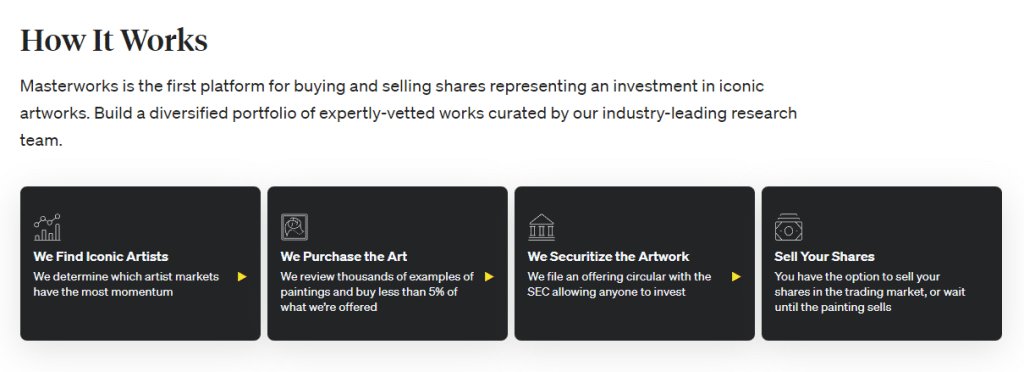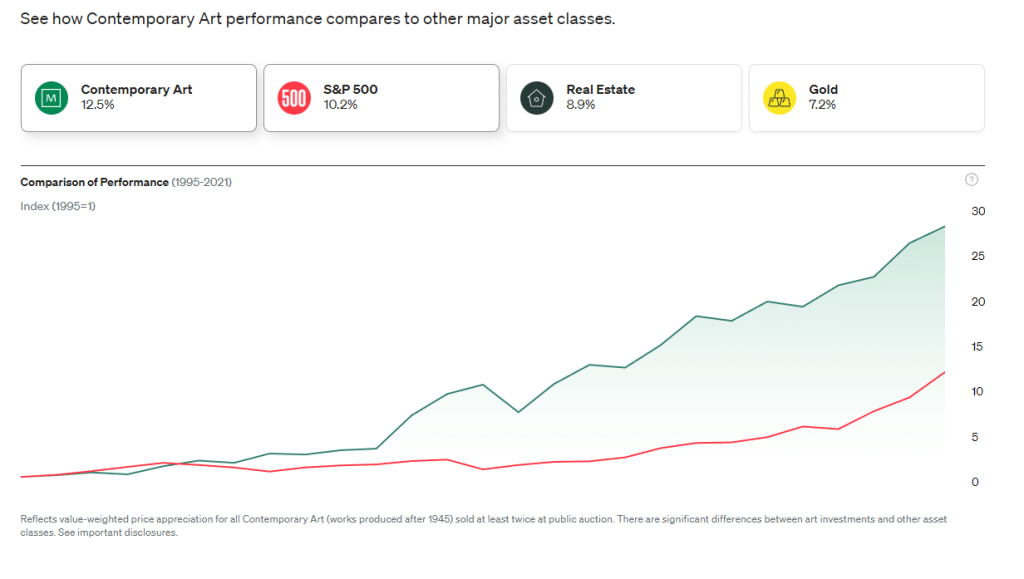Masterworks: The New Way to Invest in blue chip Art Starting at $20 a Share

Quick Summary:
Masterworks is an alternative investment platform that allows individuals to invest in fractional shares of famous works of blue chip art, like famous pieces of art from Claude Money and Banksy.
Overall Rating:
PROS
- Diversification into uncorrelated assetss
- Access to high-value artwork on a fractional basis
- Potential for high returns. Reported historical average returns of 32.3% for its past offerings.
CONS
- No cashflow from asset.
- High fees
- Illiquidity
In this Masterworks review, we will take a look at this art investing platform that allows individuals to invest in fractional shares of blue chip art. We will examine their investment process, opening an account, and whether investing with Masterworks is right for you.
What is Masterworks?
Masterworks is an alternative investment platform that allows individuals to invest in fractional shares of famous works of blue chip art, like pieces of art renowed artists such as Claude Monet and the famous street artist Banksy.

Masterworks purchases artwork reputable auction houses and then goes through the fancy legal process and is able to offer fractional shares of ownership to its investors. As the value of the artwork appreciates, investors can sell their shares for a profit. Masterworks charges fees for its services and offers a secondary market where investors can buy and sell shares.
The platform is designed to give investors access to the potential financial benefits of investing in high-value art, which was traditionally only available to a select few.

Who should invest with Masterworks?
Masterworks is good for…
- Investors looking to add diversification outside of traditional stock market investments
Masterworks is not good for…
- Investors who do not have an investing timeline of 3 – 5 years
- Investors who want to generate cashflow from their art investment
PROS and CONS
Below are some of the PROs and CONs of investing with Masterworks, which can help you quickly decide if this alternative investment platform is right for you.
PROs
- Thorough Vetting process. Masterworks purchases less than 5% of the art they are offered
- Diversification. Investing in artwork can provide diversification benefits to an investor’s portfolio, as artwork has historically had a low correlation with other asset classes, such as stocks and bonds.
- Access to high-value artwork. Investing through Masterworks allows investors to purchase fractional shares in high-value artwork that may be otherwise inaccessible due to their high price points.
- Professional management. Masterworks handles all aspects of maintenance, storage, and insurance for the artwork, which can alleviate some of the administrative burdens associated with investing in artwork.
- Tax benefits. Investors who hold their shares for at least one year may be eligible for long-term capital gains tax treatment, which has a lower tax rate than short-term capital gains.
- Potential for high returns. While past performance does not indicate future results, Masterworks has reported historical average returns of 32.3% for its past offerings. Artwork can be a profitable investment if it is purchased at the right price and increases in value over time.
CONs
- High fees. Masterworks charges several fees for its investment services, including upfront fees, annual management fees, performance fees, and transfer fees. These fees can add up and may reduce an investor’s overall returns.
- Illiquidity. Artwork is an illiquid asset, meaning that it may be difficult to sell quickly if an investor needs to access their funds. While Masterworks has a secondary market where investors can buy and sell shares in artwork, liquidity may still be limited.
- No intrinsic value. Art’s valuation can likely only be done through comparable sales. Creating a basket of goods that are comparable to art is nearly impossible. How does one compare a Picasso to a Monet?
- No cashflow. Art investments do not generate dividends or coupon payments.
How does Masterworks work?
Masterworks allows investors to purchase fractional shares of blue chip art, that are held by the company in a secure storage facility. Here’s how the process works, from asset acquisition to disposition.
1. Artwork acquisition
Masterworks acquires blue chip artwork, like pieces from Monet and Banksy and then registers it with the SEC.
2. Share creation
After the art is registered with the SEC, Masterworks divides the artwork into smaller, more affordable fractional shares and offers them for sale to investors through its platform.
Investors can then purchase fractional shares of the art, starting at $20 a share with a minimum investment around $1,000.
3. Holding period
Masterworks holds the artwork in a secure storage facility and handles all aspects of maintenance, insurance, and storage. Masterworks provides an appraisal of the art 6 months after issuance, and quarterly thereafter.
4. Selling shares
As the artwork increases in value, so does the value of the investor’s shares, and Masterworks plans to sell most of the artworks in around three to 10 years.
However, should you want to sell your shares early, investors can sell their shares on Masterworks’ active secondary market, which allows them to buy and sell fractional shares with other investors.

5. Taking profit
Once the art is sold, Masterworks takaes 20% of the profits as a fee.
Note: While a 20% fee seems high, it is on par with the standard fee for alternative investments.
Overall, Masterworks provides a way for investors to invest in high-value artwork without having to buy the entire piece themselves, making it more accessible to a wider range of investors.

Returns
The returns on investments made through Masterworks will vary depending on a number of factors, including the performance of the specific artwork and the length of time an investor holds their shares. Art, like any other investment, is subject to market fluctuations, and there is no guarantee of a positive return.
Factors that influence returns
- Holding period
- Market fluctuations
- Performance of the speciic artwork
However, Masterworks provides historical data on the performance of past offerings on its platform. As of this writing,
Masterworks has offered 46 artworks to investors, with an average historical return of 32.3% and an average holding period of 1.9 years. It’s worth noting that past performance is not necessarily indicative of future results.
Investors in artwork through Masterworks may also receive potential benefits from tax considerations. For example, if an investor holds their shares for at least one year, they may be eligible for long-term capital gains tax treatment, which has a lower tax rate than short-term capital gains.
Overall, investing in artwork through Masterworks can potentially offer investors an opportunity to diversify their portfolio and potentially earn a positive return, but it’s important to do your own research and consider all the risks and fees associated with the investment before deciding to invest.
Returns explained
As calculated by the Masterworks all art index, contemporary art prices have outpaced the S&P 500 by 131% from 1995-2021.
Let’s dig into the numbers.

As noted in a blog I recently read, the benchmark for contemporary art is based on an index created by Masterworks, including a selected group of around 40 blue chip contemporary artists.
In the fine print, you can see that the chart for Contemporary Art is based on an index created by Masterworks, including a selected group of around 40 Blue Chip contemporary artists.
What this means: This index is not investable, and Masterworks does not offer securities that directly correlate to Contemporary Art. That said, the returns marketed by Masterworks are accurate, and you may certainly earn superior risk-adjusted returns, but the underlying benchmark they use is dubious, so take this into consideration before investing.
Fees
While Masterwork’s fees may seem high compared to an index fund or mutual fund, their fees are on par with other alternative investments like wine or real estate crowdfunding. But like most alternative investments that carry high fees and higher risk, fine art can provide potentially higher returns than investing in traditional investment vehicles.
Let’s breakdown the main fees associated with investing in artwork through Masterworks:
Upfront fees
Masterworks charges an upfront fee equal to 1.5% to 3% of the artwork’s purchase price. This fee covers the cost of acquiring and registering the artwork with the SEC. Again, upfront fees are typical in most alternative investments and are difficult to avoid. If an alternative investment platform doesn’t have any upfront fees, it’s likely packaged in somewhere else within its cost structure.
Annual management fee
Masterworks charges an annual management fee of 1% to 1.5% of the appraised value of the artwork. This fee covers the cost of storing, maintaining, and insuring the artwork. Note, the annual management fee is taken as an equity stake in the art, so Masterworks doesn’t get paid until the art sells and are incentivized as well to make sure the art sells for a high price. The fees are high but it’s a fairly niche offering, so it is to be expected.
Performance fees
Masterworks also charges a performance fee equal to 20% of any profits realized when an investor sells their shares. This fee only applies to profits over a certain threshold (currently set at 12% per year), and is designed to align the interests of Masterworks with those of the investors.
While the management fee and 20%-of-profit fee are in line with a hedge fund’s industry-standard, these fees are relatively high when compared to investing in something like a market-tracking index fund. But like most alternative investments that carry high fees and higher risk, fine art can provide potentially higher returns than investing in traditional investment vehicles.
Transfer fees
Masterworks charges a fee of $20 per transfer for any shares that are bought or sold on its secondary market.
It’s worth noting that Masterworks only makes money when investors make money. The company does not charge any fees for unsuccessful investments.
Overall, Masterworks fees are in-line with another alternative investment platform like Yieldstreet. Either way, investors should spend time understanding the fees associated with any investment before deciding to invest.
User Experience
The user experience with Masterworks can vary depending on the investor’s perspective and level of experience. I spent significant time viewing user reviews on sites such as Reddit, Google Reviews, and Trust Pilot. Below are the common themes other users have noted about the Masterworks user experience:
User interface
Masterworks’ website and mobile app are designed to be user-friendly and easy to navigate. Investors can view their portfolio, track their investments, and view information about the artworks they have invested in.
The site offers a variety of tools to help users research and select artworks to invest in, including detailed information about each piece, including its history, artist, and previous sale prices. Users can also view a breakdown of fees associated with each investment, including management fees and performance fees, to ensure they have a clear understanding of the costs involved.
Another notable feature of Masterworks Investing is its social aspect, where users to connect with other investors and share insights and experiences. This adds a unique element to the platform, as it can help users make more informed investment decisions based on the collective knowledge of the community.
Overall, Masterworks Investing appears to offer a well-designed and user-friendly interface, with a range of tools and resources to help users make informed investment decisions. Its social aspect is a standout feature that sets it apart from other investment platforms, and its customizable dashboard makes it easy to tailor the platform to your individual needs.
Customer support
Masterworks provides customer support through phone, email, and chat, and they are generally responsive to investor inquiries.
Opening an account
The investment process with Masterworks is straightforward, but it can take some time to complete. Investors must first create an account, link their bank account, and complete a suitability questionnaire to determine if they are eligible to invest in art.
One of the most comment concern other users have noted is the account opening process. In order to open an account, you must speak with a Masterworks rep before your accounts is opened. Some users have noted the process is very sales-y, and turned them off, however there wasn’t a pressure to invest any ridiculous amounts of money or the like.
Best Alternatives
If you’re not quite sold on Masterworks, below are some of the best alternatives to Masterworks.
Yieldstreet
Yieldstreet is a platform that allows investors to invest in alternative asset classes, including art, real estate, and commercial loans. They offer a range of investment opportunities with varying risk profiles, and their platform is designed to be accessible to non-accredited investors.
Fundrise
Fundrise is an online platform that provides access to real estate investments. While not directly related to art, real estate can provide diversification benefits to a portfolio and can offer potential for strong returns.
Public
Public is a mobile-first investing platform that enables individuals to invest in Stocks, ETFs, Crypto, Art, NFTs, Collectibles, and more – all in one place.
Rally Rd
Rally Rd is an alternative investment platform that allows individuals to invest in collectible assets such as classic cars, rare watches, and sports memorabilia. The platform offers investors the opportunity to buy shares in these assets, enabling them to own a fractional interest in them without having to purchase the entire asset.
The Bottom Line
Investing with Masterworks is a unique opportunity to diversify your portfolio outside of traditional stock market investments. Given the limited liquidity of the investment and the long holding period of the investment Masterworks isn’t for everyone.
That said, art is an interesting market and it is here to stay, given the low investment requirements it presents a unique opportunity for investors, plus, it’s kinda cool to say you are partial owner in a Banksy or Monet painting.
Frequently Asked Questions
Below are some of the most common questions investors ask before investing in Masterworks.
Is Masterworks Legit?
Yes, Masterworks is legit! While the company is new-ish (founed in 2017) all of it’s investment opportunities are registered with the SEC.
Do I have to pay taxes on my investment?
At year end, investors will receive a K-1 tax form, which they can use for tax purposes.

